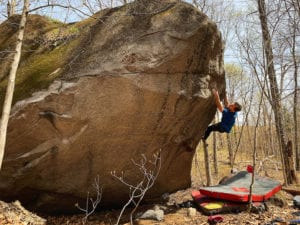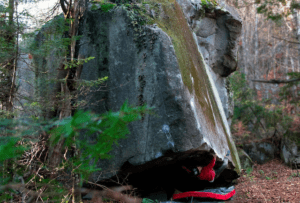Bouldering at Quebec’s Morin-Heights
Developer Mathieu Elie and climber Emile Baril describe the Morin-Heights boulders and the production of an upcoming online guidebook.

When we consider bouldering in Canada, our first thought is often the white granite of Squamish. The smooth, sharp shapes certainly represent some of the country’s best climbing, but across the country in Quebec’s Morin-Heights, another burgeoning bouldering area is emerging onto the scene. Though not as dense, it represents some of Canada’s greatest potential.

Emile Baril and Mathieu Elie represent two of many climbers and developers working in the Laurentides an hour north of Montreal. The two friends have each been bouldering for years, and, together, explore and develop one of Canada’s newest and most secret bouldering areas.
Baril began climbing in 2012 following the passion of his sister Corinne Baril. Today, Corinne is a routesetter at Bloc Shop, while Baril spends most of his time bouldering outside.
Elie has been around Quebec bouldering for quite a bit longer than Baril. He began bouldering over 12 years ago in the forests around Montreal. When these two began climbing, it was a very different experience from what new climbers might experience today.
Baril said, “Back when I started climbing, when Matt started climbing, you would go to the gym just to be able to go boulder outside. The crew I climbed with at Horizon Rock were all outdoor boulderers. It was just nonsense to only climb in the gym. Those guys brought me out and showed me the lay of the land.”
Elie continued, “The year after I went to the gym, we went to Val David. We didn’t have crash pads so we brought some mats and put them in garbage bags. It was sketchy but it was fun. I went back a few times, and it didn’t take long until we realized that there was probably more rock around here.”
Upon this realization Elie would begin another passion, one that worked well with outdoor bouldering. He would begin his history of development.
“My first first-ascent was 2011. I knew some of the guys that were doing some of the earlier development in the area. I was trying to talk to them, but it was not that easy. They didn’t really want to share information, so I went to find the boulders myself. It wasn’t super easy at first, people were not psyched that there were new climbers going to their areas and stealing their potential first ascents.”
This hesitance to share route information with the new-generation is not new in rock climbing. In some ways, it is understandable. In areas that exist exclusively on private property, climbers live in fear of area closures or trespassing fines. In addition, route development takes a lot of work. When you spend days, or perhaps even weeks searching for a new area, it can be difficult to relinquish that area’s coordinates if you are wanting to establish the crag by yourself.
Elie continued, “I got pretty psyched on finding boulders. When you put effort into it, time into brushing, and are finally able to climb the lines, it becomes pretty addictive. You want to do it again and again.”

This psych for route development is crucial for the creation of an area. Though bouldering does exist all over the province, we spoke with Elie and Baril about the Morin-Heights bouldering area.
To begin, the rock is sick. Baril said, “It’s a sharper, older granite than Squamish. It’s cool and it’s diverse.”
Elie built off of Baril, saying that, “When you find the really good lines in the Laurentides you find unique features that you wouldn’t find in other places. You learn to love granite and get used to it. It is probably my favourite type of rock and I don’t think I would have said that many years ago. You learn to appreciate the technical climbing it provides.”
After years of effort, Elie and the many other developers that are essential to bouldering in the Laurentides and Morin-Heights and have built an extensive list of first ascents. Of those problems, Elie has begun to build a guidebook that can help describe the Morin-Heights area. Why haven’t we seen it? Well, there are just a couple access issues to roll out.
Though much of the park is easy to access, there are areas that take more effort to access. The greatest issue is the parking.
Fortunately, Elie is not alone in his battle to attain access. The Fédération québécoise de la montagne et de l’escalade (FQME) exists, in part, to support climbers in exactly this manner. Elie said, “I was talking to the FQME to see if they can help, and they were more than willing. It is nice to have an organization that can help with those kinds of things.”

Though opening areas takes a lot of work from a lot of people, it offers climbers the opportunity to experience some exceptional blocs. Though Elie is but one of a large number of dedicated developers, the potential in the Morin-Heights area, among other areas, for further development is extensive.
According to Elie, “There is a lot of potential. I am not a very strong climber, and most of the developers aren’t very strong either. Many of us can climb up to V11, maybe V12 if they are in their best shape, but by today’s standards that’s not very strong. More climbers have become interested in the region in the past years. Yves Gravelle and Seb Lazure and have become interested in some of the lines that we found, and even sometimes go back to boulders to find lines that we didn’t see because we were not strong enough or we didn’t have the vision.”
Though Elie and the other developers are undoubtedly strong by conventional standards, in terms of high-end route-developing, professionally-strong climbers are required to develop the more challenging boulder problems.
“That is another type of development: strong climbers, going back to boulders that were found years ago but have not yet been developed because the level was not there. These guys haven’t been to all of the areas yet, but I am sure once the guidebook comes out, there is going to be more opportunity for them to check out lines and find the hard stuff.”
Does that mean that only V13 and up remains to be discovered? Actually, it is quite the opposite. As developers focus on the boulders that most excite them, and these climbers tend to be rather strong even if they do not climb V13, there is plenty of potential for lower-end development as well.
Elie and Baril mentioned that people should not feel intimidated to reach out. Baril continued, “More and more people are commenting or messaging, ‘Dude, where is this?’, and it is not a problem to tell people where the boulders are. You can get to the boulders and climb some megas. If it’s not in someone’s backyard where you would get kicked out, then sure, go climb it.”
“It is always my pleasure to tell people where the boulders are if the want to go! Just don’t steal my project,” Elie laughed.
“If you find some inspiring stuff that you want to clean. Just bring a wire brush and clean it and climb it. Send me the info and I’ll put it in the guidebook. It would be my pleasure to do that. I wish there were more people that would participate in this.”
Though it is always scary to talk to strong climbers, it is also important to remember that they too began as participants that were new to the sport. As far as the publication date for the guidebook is concerned, Elie said, “I have been talking to the FQME and they are supposed to reach out to Morin-Heights City and see what we can do about parking. If we can make it official, if we can settle that problem and find a solution, I am going to publish it.”
In the meantime, the winter training season is beginning in and around Montreal. Elie, and the other developers will spend the winter months training to become stronger, all while searching for Spring’s newest mega lines. What will the future hold?
Featured image of Noah Napier on Le Shérif.


